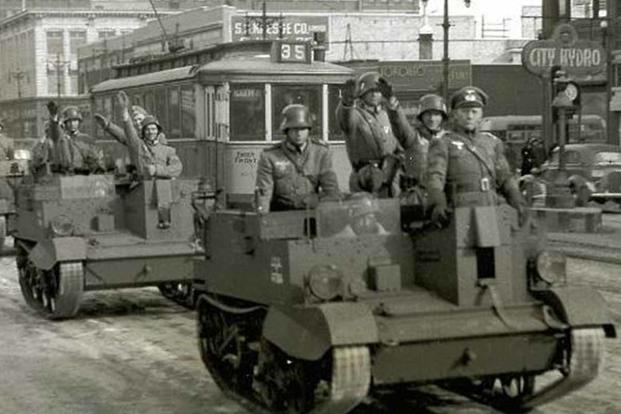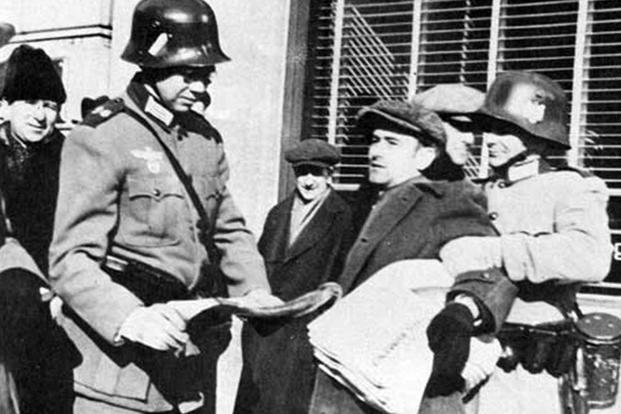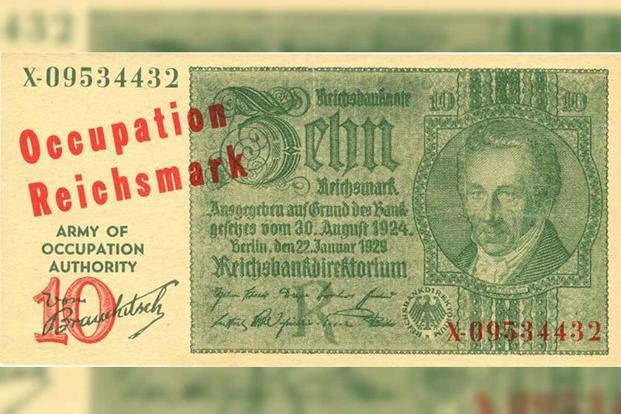There was very little doubt about what Canada would do in the wake of Nazi Germany’s invasion of Poland in September 1939. When the country entered World War II, it became the first war that Canada ever declared, independent of Britain. But war is a costly venture and Britain couldn’t foot the bill. Ottawa needed to raise its own funds.
For Canada, the final price tag of World War II would be upward of $21.8 billion. When adjusted for inflation, that number balloons to a whopping $450 billion. But back then, the wartime allies raised money for the war effort by issuing war bonds, securities issued by the government to both raise money and get civilians at home involved with the war abroad. It was a good investment -- if you were certain your government would win the war.
Canada was certain the Allies would win World War II, but in 1942, there was still a long way to go and a lot of money to be raised. So it decided to show Canadians exactly what it would look like if the Nazis controlled their country. On Feb. 19, 1942, citizens of Winnipeg woke up to find the city occupied by the Wehrmacht, an occupation complete with German tanks in the street, the Luftwaffe in the skies, their currency changed to an occupation currency and their city renamed to “Himmlerstadt.”
Long story short, the plan worked.

Canada had a lot of luck with war bonds. During World War I, the Canadian government raised $2 billion in funds through war bonds, an enormous sum at the time. It looked to do it again for World War II. At first, it began selling War Savings Certificates, which would provide a $5 return for every $4 invested, with a $500 cap on purchases. It was successful; so successful, in fact, that Canada loaned some of the revenue to the British government. But World War II was about to be the most expensive war in human history, and a $500 cap per person wasn’t going to cover the check. That’s where Victory Bonds came in.
Victory Bonds were Canada’s war bonds, which matured between six and 14 years while offering between 1.5% and 3% returns. They were also issued in denominations -- between $50 and $100,000 -- that could make them a good investment for individuals or businesses. The best part was that there was no limit to how much anyone could buy. When the government held its first bond drive in February 1940, it sold out $200 million within 48 hours. Six months later, a $300 million drive sold out just as fast. There was a drive every six months, each asking for more and more.
Many who didn’t purchase bonds were called into their bosses’ offices and reminded of the importance of duty, honor and patriotism. The Canadian government would later invest tens of millions of dollars in promoting Victory Bonds through propaganda campaigns that included movie trailers, radio commercials, posters, newspaper ads and local committees, which kicked off bond drives with visits and parades from celebrities, war heroes and politicians. Then the Canadian government tried something different: invading its own territory.
To be clear, the invasions weren’t a shooting war, but it was probably just as surprising for Canadians in Red Deer, Alberta, when tear gas and fog filled the streets and armed troops dressed as German soldiers seized the telephone building, railways, city hall and main thoroughfares. As military trucks filled with armed troops drove around, citizens were stopped by armed foot patrols as their occupiers “executed” the mayor, city clerk and other officials.
“Within 15 minutes, the troops had disappeared,” author Jeffrey Kreshen related in his 2004 book, “Saints, Sinners, and Soldiers: Canada's Second World War.” “The city settled back to normal with no outward trace of the raid, except in the minds of its citizens, who had been given an hour’s lesson on: ‘Buy Victory Bonds.’”

Perhaps the most audacious lesson came in Winnipeg on Feb. 19, 1942, at an event now remembered as “If Day,” when the Greater Winnipeg Victory Loan Organization staged the largest military exercise in the city’s history. Residents awoke to the sounds of air-raid sirens and blackout orders. Royal Canadian Air Force planes, repainted with German markings, conducted a pre-invasion “blitz” on the city as anti-aircraft tanks returned fire (with blanks).
Some 3,500 Canadian Forces fought each other in mock combat for control of the city, the defenders forming a circle around downtown. Bombings were simulated with dynamite and coal dust to “destroy” bridges and other important infrastructure. Before the sun ever rose, volunteers from the Young Men's Section of the Winnipeg Board of Trade -- wearing jackboots, belts and helmets -- patrolled the newly captured city. As Winnipeg’s citizenry began their usual days, they found a few things had changed after the “battle.”
Their morning newspaper was no longer The Winnipeg Tribune; it was now Das Winnipegger Lugenblatt and full of Nazi propaganda. The radio fared no better, as the usual announcer found himself forcibly taken off the air and detained in the early morning hours, replaced by Nazi propaganda and Adolf Hitler’s speeches. When residents went to buy their morning bread, milk or coffee, they might have paid in Canadian dollars but were given change in Occupation Reichsmarks. As the Nazi swastika replaced the Canadian flags, residents found their city name changed to “Himmler City” and Main Street renamed “Hitlerstrasse.”

Some Winnipeggers knew the invasion wasn’t real, but only those who read the daily newspaper and happened to see the notice at the bottom of the second page two days before the event. This means that many, many Winnipeg residents thought the occupation was real as city officials were arrested and taken to internment camps and the “Gestapo” began enforcing a new, repressive set of laws. They even burned books outside of the local library.
This day of complete occupation lasted a full 12 hours. After 5:30 p.m. local time, the “prisoners” were released and a Victory Bond parade began. When the stunt ended, the Greater Winnipeg Victory Loan Organization raised $3.5 million in Victory Bonds on that day alone.
Want to Learn More About Military Life?
Whether you're thinking of joining the military, looking for post-military careers or keeping up with military life and benefits, Military.com has you covered. Subscribe to Military.com to have military news, updates and resources delivered directly to your inbox.
















